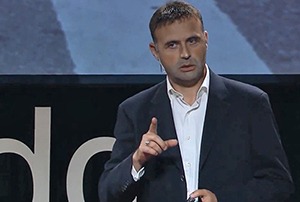
Blindness is Just Another Way of Seeing

Musings Blog (Mass. Eye & Ear Infirmary)
Earlier this fall, Lotfi Merabet, O.D., Ph.D., MPH, delivered a talk, “Blindness is Just Another Way of Seeing,” at TEDx Cambridge. As the director of the Laboratory for Visual Neuroplasticity, Dr. Merabet focuses his research on understanding how the brain adapts to the loss of sight.
To kick off his TEDx talk, Dr. Merabet showed a brief video clip of a –- forgive the possible redundancy –- frenetic Manhattan intersection as throngs of pedestrians hustled across the major thoroughfares. In a follow-up photo, a blind man stood on a similar street corner with his walking stick.
“So as you’re waiting for your turn to cross the street, what sorts of thoughts are going through your mind right now?” asked Merabet, pointing to the sightless man. “Is it curiosity? Is it indifference? You might be feeling a sense of pity. You might also be feeling a sense of relief that you, yourself, aren’t blind.”
If the blind man senses your presence and suddenly asks for directions, how would you give directions to a person who can’t see? “I’ll give you a hint,” Merabet said, answering his own question. “Pointing, or saying something like, ‘over there,’ is not very helpful for a blind person.”
In a survey conducted by the American Foundation for the Blind, participants listed blindness as the medical condition that would have the greatest impact on their quality of life. Blindness topped serious health conditions such as cancer, heart attack, stroke and HIV/AIDS. The survey indicates, as Merabet pointed out, that most Americans would rather “take their chances” with a life-threatening condition than be blind.
“To understand what blindness is, you must first understand what it’s not,” Merabet continued. "When I'm at cocktail parties and events, I'll often ask colleagues, friends and acquaintances what they think it’s like to be blind. . . . I don’t get invited back very often.”
"Darkness," "blackness," "dense fog" and "being locked inside" a coffin are the most common responses to Merabet’s uncomfortable question. “As a sighted person, I can tell you that blindness has nothing to do with living in the dark,” Merabet said, countering the most commonly held perceptions of blindness.
To prove his point, Merabet told the audience about Esref Armagan, a profoundly blind painter. That’s right, a blind painter. Merabet then displayed kaleidoscopic paintings of a seascape, a vase of flowers and a waterfall, all easily recognized and all painted by the blind Armagan.
“How can you paint a picture of an ocean if you’ve never seen an ocean?” asked Merabet. “The answer is that behind Esref’s eyes that can’t see is a brain that does see.”
Merabet knows that a blind person’s brain can “see” thanks to Functional Magnetic Resonance Imaging (FMRI), a diagnostic tool that enables clinicians to identify the parts of the brain that are associated with doing a particular task.
In Armagan’s case, he was asked to sketch while he was lying in the FMRI machine. Merabet and his colleagues discovered that the part of Armagan’s brain that was active while he was drawing – the occipital lobe – is exactly the same part of the brain associated with vision in sighted people.
When asked why he paints, Armagan said, “I paint because I want to show the world the images that are alive in my mind. When I paint and I show my drawings to sighted people and they tell me what they see, I feel connected to the sighted world.”
After a pause, Merabet noted, “Clearly, this is not someone who’s living in the dark.”
Despite this remarkable ability to “see” the world around them based on other sensory clues, there are some situations that blind people find particularly vexing, most notably finding their way in unfamiliar surroundings.
“With this in mind," said Merabet, "we want to come up with new tools, new approaches to help blind people circumvent this challenge."
To learn what tools Merabet and associate Jamie Sanchez are developing to help blind children learn to navigate new surroundings, watch Dr. Merabet’s 15-minute TEDx Cambridge talk.
Post a comment